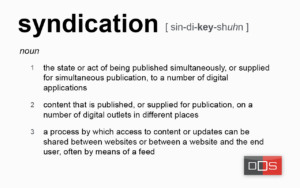Syndicating Manufacturer Content to All Channels, Part 2

Matt Christensen
PresidentMarch 16, 2021
In Part 1, we defined full-channel product content syndication and explained why most manufacturers are lacking a true comprehensive solution for delivering content across their entire channel. The next question to answer is:
What does the typical product content syndication process look like for manufacturers (and their distribution partners)?
Ever wonder why e-commerce is so difficult and slow to reach maturity in many wholesale industries? A major reason is the exchange of product content.
In talking regularly to manufacturers and distributors (regardless of size or industries served), there is often frustration by both parties in understanding why it’s so difficult to exchange and work with product content. They have the same goal—getting content on a website—but they have different systems, different processes, and sometimes different definitions of what content they want on said site.
The manufacturer direct-fulfillment approach
For distributors, asking a manufacturer for their product file may seem like a simple request. And manufacturers may assume that one product file format ought to suffice for multiple, if not all, their distribution partners’ needs. (Neither assumption is true.) Considering their distinct perspectives, it can be helpful to understand some of the complexities for companies on either side of this exchange.
Again, with literally hundreds of distribution partners asking a given manufacturer for their product file, we see many manufacturers attempt to fulfill their “Top 10” partners’ template requests, while everyone else may receive a singular, stripped-down template, whether directly from the manufacturer, their syndication partner, or an industry-sponsored data warehouse.
The problem with the “Top 10” scenario is that maintaining even a modest number of unique formats is still a very manual process that is just not sustainable for a manufacturer’s data team.
The problem with the second, “one-size-fits-all” scenario is that for most distributors or retailers—who conversely work with hundreds or thousands of manufacturers—this becomes yet one more data format variant that each of them has to work with, leading to significant delays in ultimately utilizing your content. (We definitely see distributors prioritize adding their top vendors’ content over the rest in this case.)
Neither scenario is efficient, let alone ideal, for these companies.
The self-serve strategy
Many larger manufacturers have taken the initiative to create custom portals for their channel partners, giving them the ability to download product content, place orders, and check pricing and inventory availability. While investing in such a system seems like a good idea from the manufacturer’s perspective, it creates a few significant obstacles for their distribution partners, resulting in a lack of adoption and use.
Among the issues we have seen with this “self-serve” approach, as it pertains to downloading content, is that retailers in particular won’t use it, because they require product data to be pushed to them, either through their own proprietary portals or through a retail-focused syndicator.
Retailers aside, the rest of the channel is hesitant to use these portals to download product data—especially on a consistent basis—because once again, even a medium-sized distributor or wholesaler works with hundreds of manufacturers (larger ones typically have a thousand or more vendors), each with their own unique format, data structure and naming conventions.
(If you’re a distributor and have to go to 200 different portals every month to download all your manufacturers’ content, how many times a year do you think you would do it?)
And we aren’t even scratching the surface of the actual legwork involved in this process. No matter where the files come from, because manufacturers aren’t consistent in how they provide the content, each distributor must transform all of this disparate content into a singular and specific format as required for uploading to their individual e-commerce platforms (not to mention the other specific formats for their ERPs, PIMs, apps, digital catalogs, and other systems).
(And remember, they have to do this every time they download or receive a new file.)
As any experienced distributor can confirm, this takes a tremendous amount of “time, talent and technology,” which for most companies is a significant investment.
Regarding the question above, we happen to know exactly how often distribution partners are realistically willing and/or able to do this…
We saw one very large global manufacturer set up a self-service portal for their content, and at the end of the first year, only two of their distributor partners (out of 300) downloaded their content because the tool was difficult to use and required training by internal and external staff—not to mention the content contained countless errors. There are many such examples.
Again, building their own portal may help a manufacturer manage content on their end, but it ultimately puts the burden on their distribution partners to get the content onto their site, which, considering the number of suppliers they work with, is likewise unsustainable for even the most resource-rich companies.
What about dedicated industry data sources?
Industry-sponsored data warehouses have been prominent in some verticals in North America and Europe. These were typically created by industry associations or buying groups to fill the need for their members for the storage of basic ERP-type transactional content like pricing, catalog numbers, invoice descriptions and packaging information. We have seen numerous problems with these legacy models as they try to adapt to the very different market demands of today’s e-commerce content experience—being driven by Amazon and others. For starters, these data warehouses almost always require a very manual process for manufacturers to upload their content—into a rigid, basic, one-size-fits-all template—resulting in the loss of each manufacturer’s valuable marketing and differentiating information.
The electrical industry is a prime example, where we hear that many manufacturers are now only uploading their content to the “official” data warehouse a couple of times each year—again, due to a time-consuming and costly manual process that often times requires dedicated staff.
But the worst part is, more and more manufacturers are taking a closer look at the actual usage stats and finding that many of their largest distributor partners are only downloading their content just two (and in many cases zero!) times per year, or when the manufacturer posts product pricing updates, because the content is so limited, difficult to use, and simply not sufficient for e-commerce. To top it all off, this model often satisfies only a portion of the manufacturer’s channel, since it requires each distributor to be a paid subscriber. So, if your channel partner doesn’t subscribe to that particular industry data source, you have to find another way to get them your content.
And retail-focused syndication companies?
As mentioned previously, retail-focused syndication companies are often used when manufacturers want to push their content to large retailers like Walmart, Target and Lowe’s. They are seldom used within the B2B wholesale or distribution space (unless they have divisions or brands that focus on large retailers) due to their limited flexibility and high costs.
We have heard from several manufacturers that it is once again a manual and difficult process to populate their content into these platforms, with content limitations and/or inability to create custom feeds for their channel partners. Multiple manufacturers who have tried these retail syndication providers have consistently remarked that they were “oversold” in what these companies could actually provide.
Sadly, with all the companies involved in “figuring this out,” it sure doesn’t feel to manufacturers (or their channel partners) like anyone has this figured out. (At least not until they talk to us.)
Knowing is half the battle
While an ever-increasing number of manufacturers are definitely “feeling the pain” and actively searching for better solutions, it’s worth noting that we see many manufacturers’ Sales, Marketing and Channel executives who don’t know that they have some of these issues. Ask your channel leaders and data department if they are having any (or all) of these problems. From what we have seen, even most of the largest manufacturers in a given industry have these issues.
Again, this has forced many suppliers to have to engage multiple companies in order to get their content to a diverse distribution network. This fragmented approach is costly and inefficient in terms of both time and resources.
As we’ll cover in the third and final part of this blog, manufacturers today need a partner who can offer true full-channel product content syndication, helping them manage the complex process of delivering their content consistently—and, dare we say it, easily—to all their channel partners, regardless of company type or industry.
We’ll also unveil the four requirements that such a provider should meet, so stay tuned for that.
If you’d rather find out sooner, just give us a call (888-350-DATA) or contact us today!

Keep Reading
Next up: the final chapter, Syndicating Manufacturer Content to All Channels, Part 3

Read Part 1
If you haven’t already, read Syndicating Manufacturer Content to All Channels, Part 1
